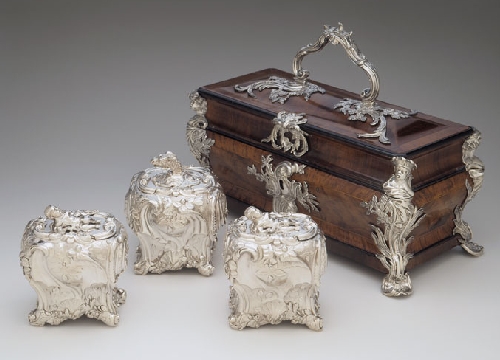Tea Equipage in England
Tea Equipage by Paul de Lamerie, 1735
 Tea Equipage by the great goldsmith Paul de Lamerie is illustrated (by kind permission of Leeds Museums and Galleries - Temple Newsam House). It dates to 1735 and has a set of 12 cast whiplash teaspoons, a mote spoon, an unusual pair of tea tongs, a set of twelve tea knives, two tea caddies, a sugar caddy and a milk jug; all these are housed in an elegant, silver mounted, fitted shagreen box. The maker of the tea tongs is John Allen I - a fairly prolific early maker - and it is interesting to note that Paul de Lamerie saw fit to buy in those tongs rather than have tem produced in his workshop. This seems to have been by no means unusual, as other such examples have been recorded. Source: Dr. David Shlosberg, "Eighteenth Century Silver Tea Tongs"This equipage, the earliest complete English tea set preserved, was made as a wedding present for the Huguenors Jean Daniel Boissier and Suzanne Judith Berchere who were married at St. Peter le Poor, London, in April, 1735, and later purchased Lime Grove, Putney. The bride's father, Jaques Louis Berchere, from Paris, a jeweler and banker in Broad Street and an officer of the French church, Threadneedle Street, was probably responsible for the commission. Jean Daniel was the son of Guillaume Boissier, admitted as a Burgess of Geneva in 1695.
Tea Equipage by the great goldsmith Paul de Lamerie is illustrated (by kind permission of Leeds Museums and Galleries - Temple Newsam House). It dates to 1735 and has a set of 12 cast whiplash teaspoons, a mote spoon, an unusual pair of tea tongs, a set of twelve tea knives, two tea caddies, a sugar caddy and a milk jug; all these are housed in an elegant, silver mounted, fitted shagreen box. The maker of the tea tongs is John Allen I - a fairly prolific early maker - and it is interesting to note that Paul de Lamerie saw fit to buy in those tongs rather than have tem produced in his workshop. This seems to have been by no means unusual, as other such examples have been recorded. Source: Dr. David Shlosberg, "Eighteenth Century Silver Tea Tongs"This equipage, the earliest complete English tea set preserved, was made as a wedding present for the Huguenors Jean Daniel Boissier and Suzanne Judith Berchere who were married at St. Peter le Poor, London, in April, 1735, and later purchased Lime Grove, Putney. The bride's father, Jaques Louis Berchere, from Paris, a jeweler and banker in Broad Street and an officer of the French church, Threadneedle Street, was probably responsible for the commission. Jean Daniel was the son of Guillaume Boissier, admitted as a Burgess of Geneva in 1695.
The three canisters and cream jug bear the London hallmarks for 1735-6, and were specially made for the set. The other items were not hallmarked. The canisters are engraved with initials G., B. and S. for Green tea, Bohea tea and sugar respectively. With the exception of the strainer spoon and sugar nippers, every peace, including silver mounts on the original velvet-lined mahogany case, is engraved with the arms of Boissier impaling Berchere. The intervinted handles of the 12 spoons, the elaborate scroll handle of the cream boat, and the chased, cast and engraved ornament on the canisters are early examples of the Rococo style in English silver, of which Paul de Lamerie was the leading exponent. The knives (used to cut the cane-sugar) and the sugar nippers were supplied by a specialist John Allen, who registered his mark as a smallworker at Goldsmiths' Hall in May, 1733.
"The Quiet Conquest - The Huguenots 1685 to 1985", The museum of London
Combination of Whip patten and Rococo Foliate Scroll Work Originated Rococo Grand pattern
The design of teaspoons in Paul De Lamerie's Tea Equipage combines the Whip pattern and Rococo foliate scroll work, of which no other examples have come to light.
This combination clearly originates the Rococo Grand pattern which would be characterised by the combination of bigger Rococo foliate scroll work with Whip pattern's pieced 'S' curve, the shell-shaped bowl, Ionic scrolls order on the front side and "rocaille" decoration on the back side of the joint part between the stem and the bowl.
Most of Rococo Grand pattern teaspoons were producted from 1736 to 1750s.
Seiji Yamauchi
Whip pattern Teaspoons, 1735
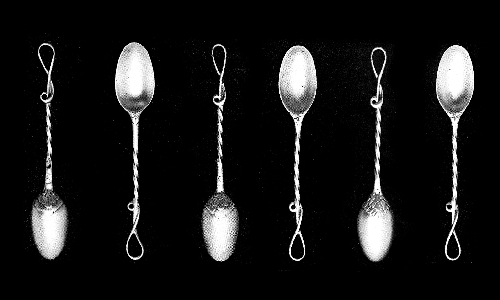 Whip pattern. Set of 6 mid-eighteenth century teaspoons. These are only known examples of teaspoons in the pure form of this pattern. Courtesy Victoria and Albert Museum. Source: "SILVER FLATWARE English,Irish and Scottish 1660-1980", Ian PickfordThe Whip pattern is one of the most rare of those known from the eighteenth century. Its name derives from the shape of the stem which is formed like a whip with its end bent over and coiled back round the stem. Until recently it was only known from mid-eighteenth century salt spoons. The discovery of the illustrated teaspoons, together with the examples by Paul de Lamerie which combine Whip with rococo naturalism, show that the range of this pattern must have been greater although no other examples have come to light.
Whip pattern. Set of 6 mid-eighteenth century teaspoons. These are only known examples of teaspoons in the pure form of this pattern. Courtesy Victoria and Albert Museum. Source: "SILVER FLATWARE English,Irish and Scottish 1660-1980", Ian PickfordThe Whip pattern is one of the most rare of those known from the eighteenth century. Its name derives from the shape of the stem which is formed like a whip with its end bent over and coiled back round the stem. Until recently it was only known from mid-eighteenth century salt spoons. The discovery of the illustrated teaspoons, together with the examples by Paul de Lamerie which combine Whip with rococo naturalism, show that the range of this pattern must have been greater although no other examples have come to light.
In 1766 William and Thomas Chawner supplied Parker & Wakelin with 'Twisted handle salt spoons' (Garrard Mss. Workmen's Ledger No. 2, Victoria abd Albert Museum). This may referto the Whip pattern, although salt spoons with twisted handles of other patterns do occur at this period, such as the Onslow.
"SILVER FLATWARE English, Irish and Scothish 1660-1980", Ian Pickford
Rococo Grand pattern Gold Teaspoons by Francis Harrache, 1745
Gold teaspoons with a pair of tea tongs by Francis Harrache, circa 1750, in the Gilbert Collection.22-karat gold standard
Maker's mark : FH with a crown above for Francis Harache
Spoons : Length:10.5 cm, Weight 22 gm
Sugar Tongs : Length:12.8 cm, Weight:58 gm
Provenance : Sir John Noble, Bart., Ardkinglass.
Sale : Sotherby's, February 6, 1986, lot 48.
The spoons each have a shell-shaped bowl, which is chased on the outside and plain on the inside, with a leaf molding chased on the lower frontjunction. The upper end of the stem is chased on both sides with foliage, scrolls, and shell motifs. The nippers are of scissor form, with similar bowls and decoration.
The spoons are apparently raised from a single piece of metal and the nippers from two pieces, with a central pin through the pivot point.
Two sets of mid-eighteenth-century gold teaspoons are recorded by Arthur Grimwade, one of about 1745, with a pair of nippers, by John Wirgman, and the other of about 1750, unmarked, with a pair of sugar tongs and a straining spoon. The former are of plain Hanoverian pattern, but the latter are of similar pattern to the Gilbert set.
English gold plate other than snuffboxes and freedom boxes is very rare: a list published by Grimwade of all items then known from the period 1507-1830 falling outside the above-mentioned categories amounted to only about eighty objects. Inevitably, other examples have since come to light; indeed, neither these spoons nor the Gilbert gold waiters and cup and cover were recorded by Grimwade at that time.
"The Gilbert Collection - Silver and Gold", Los Angels County Museum of Art
Six Rococo Grand pattern Gold Teaspoons, unmarked, 1750
 Set of six gold teaspoons in mid-eighteenth century rococo style. London, 1896, A. & A. H. Benson for Hunt & Roskell. Courtesy Sotheby's. This set of six gold teaspoons was made about 1750, unmarked, with a pair of sugar tongs and a straining spoon. It is of similar pattern to the Gilbert set however the inside of the bowl was casted as shell form.
Set of six gold teaspoons in mid-eighteenth century rococo style. London, 1896, A. & A. H. Benson for Hunt & Roskell. Courtesy Sotheby's. This set of six gold teaspoons was made about 1750, unmarked, with a pair of sugar tongs and a straining spoon. It is of similar pattern to the Gilbert set however the inside of the bowl was casted as shell form.
"SILVER FLATWARE English, Irish and Scothish 1660-1980", Ian Pickford
Tea Equipage, Rococo Grand pattern, by John I Derussat, 1750
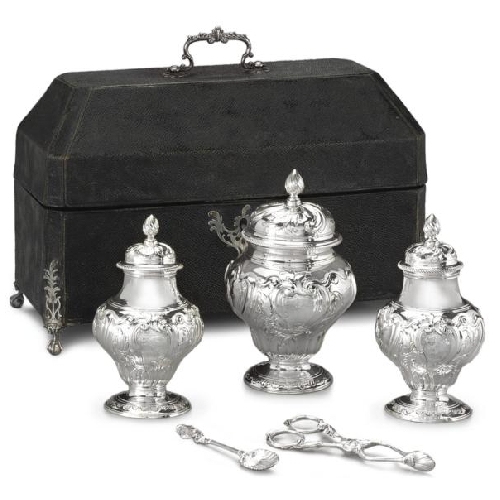 Tea Equipage by John (I) Derussat, circa 1750. Source : Cristie'sA mid-eighteenth century pair of tea caddies, sugar box and set of twelve teaspoons, and pair of sugar nippers all fitting into a contemporary black lackuered box. The teaspoons are formed as Rococo Grand pattern, and a pair of sugar tongs is matched design. Maker's mark on teaspoons, a pair of sugar tongs script JD, acorn above.
Tea Equipage by John (I) Derussat, circa 1750. Source : Cristie'sA mid-eighteenth century pair of tea caddies, sugar box and set of twelve teaspoons, and pair of sugar nippers all fitting into a contemporary black lackuered box. The teaspoons are formed as Rococo Grand pattern, and a pair of sugar tongs is matched design. Maker's mark on teaspoons, a pair of sugar tongs script JD, acorn above.
Tis set was auctioned at Christie's in 2009.
Christie's
Tea Equipage, Naturalistic pattern, by John Derussat, 1750
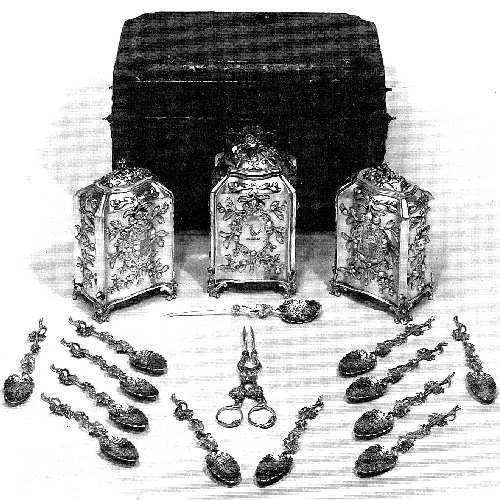 Tea Equipage by John (I) Derussat, circa 1750. Source : "SILVER FLATWARE English, Irish and Scothish 1660-1980", Ian PickfordA mid-eighteenth century pair of tea caddies, sugar box and set of twelve teaspoons, a mote spoon and pair of sugar nippers all fitting into a contemporary black lackuered box with chinoiserie scenes. The teaspoons are formed as openwork vines, with ladybirds incorporated in the decoration. Maker's mark on teaspoons, mote spoon and sugar nippers script JD, acorn above. Courtesy Phillips.
Tea Equipage by John (I) Derussat, circa 1750. Source : "SILVER FLATWARE English, Irish and Scothish 1660-1980", Ian PickfordA mid-eighteenth century pair of tea caddies, sugar box and set of twelve teaspoons, a mote spoon and pair of sugar nippers all fitting into a contemporary black lackuered box with chinoiserie scenes. The teaspoons are formed as openwork vines, with ladybirds incorporated in the decoration. Maker's mark on teaspoons, mote spoon and sugar nippers script JD, acorn above. Courtesy Phillips.
This maker's mark "script JD with acorn above" is a Huguenot silversmith, John (I) Derussat (? 1700-58) , Grimwade 3632, according to Mr. Brian Beet. He identified this important silversmith in the article "Foreign snuffbox makers in eighteenth century London", The Silver Society Journal 14, 2002.
"SILVER FLATWARE English, Irish and Scothish 1660-1980", Ian Pickford
Set of Tea Caddys by Paul de Lamerie, 1751
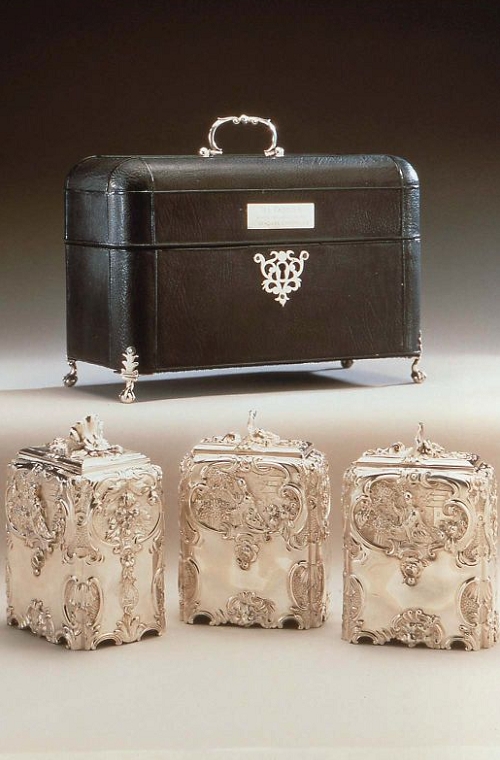 Tea Equipage by Paul de Lamerie, 1751. This set of a pair of Tea Caddies and a Sugar Box was made for Charles, 1st Marquess Cornwallis (1735-1805).This set of a pair of Tea Caddies and a Sugar Box was made for Charles, 1st Marquess Cornwallis (1735-1805).
Tea Equipage by Paul de Lamerie, 1751. This set of a pair of Tea Caddies and a Sugar Box was made for Charles, 1st Marquess Cornwallis (1735-1805).This set of a pair of Tea Caddies and a Sugar Box was made for Charles, 1st Marquess Cornwallis (1735-1805).
London, 1751–52, Marked by: Paul de Lamerie. 6.7 x 14 x 9.8 cm, 1.2 kg. Marks: Struck under base with hallmarks (leopard's head, lion passant, date letter for 1751-2) and with maker's mark of Paul de Lamerie.
Museum of Fine Arts, Boston
Silver-gilt Combination of Harlequin pattern and Naturalistic pattern Teaspoons and Mote Spoon, unmarked, 1760
 Mid-eighteenth century silver-gilt Harlequin teaspoons and mote spoon. Courtesy Sotheby's. The harlequin pattern dating from about 1760 combined with Rococo naturalistic style make this set extreamly unique. The details of the casting are superb, even down to the simian features of the face.
Mid-eighteenth century silver-gilt Harlequin teaspoons and mote spoon. Courtesy Sotheby's. The harlequin pattern dating from about 1760 combined with Rococo naturalistic style make this set extreamly unique. The details of the casting are superb, even down to the simian features of the face.
"SILVER FLATWARE English, Irish and Scothish 1660-1980", Ian Pickford
Tea Cup and Saucer by Chelsea Porcelain Factory, 1759-69
 Cup and Saucer by Chelsea, 1759-69. [Cup] H: 4.4cm, W: 8.9cm, [Saucer] Diam: 13.0cmThis cup and saucer are from a tea and coffee service for six people. Tea was generally drunk from handle-less tea bowls of the Chinese type during the early 18th century, but handled teacups were made in Britain by the 1740s. These were more costly to make than tea bowls, and they didn't pack tightly together for carriage to distant markets. Both types were in common use by the time this service was made. Teacups were usually slightly lower and had a wider rim than coffee cups, possibly because the smell of tea is better appreciated if drunk from an open bowl. Satirical prints of the years around 1800 occasionally show tea being drunk from the saucer, but it is clear that this was not done in polite company. Afternoon and after-dinner tea were generally served by the lady of the house in the drawing room in comfortably-off households.
Cup and Saucer by Chelsea, 1759-69. [Cup] H: 4.4cm, W: 8.9cm, [Saucer] Diam: 13.0cmThis cup and saucer are from a tea and coffee service for six people. Tea was generally drunk from handle-less tea bowls of the Chinese type during the early 18th century, but handled teacups were made in Britain by the 1740s. These were more costly to make than tea bowls, and they didn't pack tightly together for carriage to distant markets. Both types were in common use by the time this service was made. Teacups were usually slightly lower and had a wider rim than coffee cups, possibly because the smell of tea is better appreciated if drunk from an open bowl. Satirical prints of the years around 1800 occasionally show tea being drunk from the saucer, but it is clear that this was not done in polite company. Afternoon and after-dinner tea were generally served by the lady of the house in the drawing room in comfortably-off households.
 Cup and Saucer by Chelsea, 1759-69. [Cup] H: 4.4cm, W: 8.9cm, [Saucer] Diam: 13.0cmDesign & Designing
Cup and Saucer by Chelsea, 1759-69. [Cup] H: 4.4cm, W: 8.9cm, [Saucer] Diam: 13.0cmDesign & Designing
The service is similar to one offered at auction in London in 1770. This was described as 'a very curious and matchless tea and coffee equipage, crimson and gold, most inimitably enamell'd in figures, from the designs of Watteau'. Although the figure subjects here are not directly copied from the work of the French Rococo painter Jean-Antoine Watteau (1684-1721), they are certainly inspired by his work.
Victoria & Albert Museum
Tea Equipage in Tortoiseshell Case by Burrange Davenport, 1771
 Tea Equipage in Tortoiseshell Case by Burrange Davenport, 1771This tea equipage, made by Burrange Davenport in 1771, clearly shows the Neo-classic style. The design of tea caddy is derived from Greek vase or Roman urn and the design of the spoons is called the Bright-cut Old English pattern.
Tea Equipage in Tortoiseshell Case by Burrange Davenport, 1771This tea equipage, made by Burrange Davenport in 1771, clearly shows the Neo-classic style. The design of tea caddy is derived from Greek vase or Roman urn and the design of the spoons is called the Bright-cut Old English pattern.
Comprising a tea caddy, sugar urn, set of six teaspoons and a pair of sugar tongs; the caddy with small cap, the sugar urn with larger cover, both urn-form, on openwork square base, the body with cast applied swags and oval cartouches, with two applied raised handles, the fluted covers with pineapple finials, the cartouches engraved on one side with a coat-of-arms in shield and on the other with a crest; marked under bases and on caddy cap, also with scratchweights 14=5 and 14=13; the spoons and tongs with cast openwork feather-edge handles, the spoons engraved with a different crest, the tongs with the same crest, five spoons marked with maker's mark, in a fitted bombé tortoiseshell case inlaid with ivory borders and applied with cast silver furniture, the handle escutcheon engraved with the same coat-of-arms in a shield, the interior lined with blue silk and silver galooning, the bases of the tea and sugar urns and the silver lockplate of the case all engraved "Jan.y 1772"
Caddy 6 3/8 in. (16.2 cm.) high; case 9½ in. (24.2 cm.) long; 33 oz. 10 dwt. (1,041 gr.) weighable silver
Provenance
Collection of Colonel H. H. Mulliner, of London and Clifton Court, Rugby, sold Christie's, London, 9 July 1924, lot 1
Literature
H. H. Mulliner, The Decorative Arts in England, 1660-1780, figs. 112-115
Lot Notes
The arms are those of Bradney with those of Mico quartering Child on an escutcheon of pretence, as borne by John Bradney (d. 1809), apothecary, and his wife Martha, daughter of Joseph Mico, merchant of London.
 They were married on January 9, 1772, at St. Mary Aldermary in London, and this equipage, engraved "Jan.y 1772" on the caddies and the case, was undoubtedly a wedding present. Martha Mico was a co-heiress with a at least one sister. John Bradney's death is recorded in the Gentleman's Magazine for March 29, 1809 "At his house on Clapham Common, Surry, aged 77 John Bradney Esq. formerly an Apothecary in Tower Street, London."
They were married on January 9, 1772, at St. Mary Aldermary in London, and this equipage, engraved "Jan.y 1772" on the caddies and the case, was undoubtedly a wedding present. Martha Mico was a co-heiress with a at least one sister. John Bradney's death is recorded in the Gentleman's Magazine for March 29, 1809 "At his house on Clapham Common, Surry, aged 77 John Bradney Esq. formerly an Apothecary in Tower Street, London."
Price
This item was sold at $79,200 (estimate price 40,000-60,000) in "Important Silver and Objects of Vertu" (Sale 1773) on 26 April 2006, Christie's New York, Rockefeller Plaza.
Christie's
 Top
Top Site Map
Site Map References
References About Me
About Me